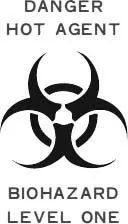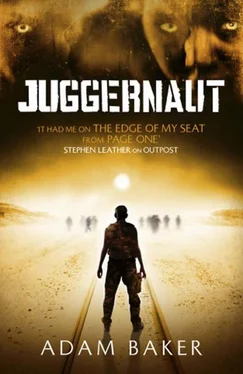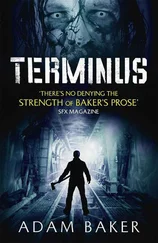‘The structure is crystalline. Almost metallic. Maybe it’s synthetic. A chimera virus, an artificial construct. Nanobots or recombinant DNA manipulation gone horribly wrong. Or maybe it is something else.’
‘Like what?’
‘It’s not a sudden mutation. It’s a complex form of life. Highly evolved. Supremely adaptive.’
‘What are you saying?’
‘It’s not from Earth.’
‘Listen to yourself,’ said Koell. ‘You had a simple job: locate the virus; bring it back. That’s all you had to do.’
‘I don’t care what happens to me. You can go to hell.’
‘Tell me about the lab.’
‘Fuck you.’
Koell stepped into view. Shirtsleeves and a butcher’s apron. He held a pair of pliers. He hunched over Ignatiev, back to the camera.
A long scream.
Koell stepped away. Ignatiev drooled blood. A front incisor missing.
‘The lab. Is it intact?’
Ignatiev coughed and spat. A weird smile. The knowledge he was minutes from death manifest as a strange euphoria.
‘Maybe. I don’t know.’
‘I’m going to send a retrieval team. A bunch of mercenaries. One of my guys will attempt to secure the virus. So tell him what he needs to know. Talk him through it. How do we get into Lab One? How is it secured?’
‘There is a keypad and swipe-slot, but it won’t work. The lab is in lock-down. I triggered a contamination alert. The doors sealed tight. None of the access codes will register. You’ll have to cut your way inside. Each unit is a double steel shell. Might take a while.’
‘The labs,’ asked Koell. ‘What will we find inside?’
Ignatiev spat more blood.
‘The main power will be off. The labs will be in sleep mode. Essential systems only. Chloride storage batteries will provide a trickle of AC power to keep the freezers operational. You will need to restart the grid. It’s easy enough. There’s a fuse box as you enter Lab One. On your left, at head height. One of those lightning bolt high-voltage stickers on the lid. There is a single breaker inside. You will be able to run at full power for about seventy-two hours before you need to fire up the generator to recharge.’
‘Tell me about Lab One.’
‘We used the first unit as a necropsy room. Specimens were brought for dissection and analysis. That was where most of our work took place once the human field tests began.’
Gaunt examined the lab door. A steel hatch, like the bulkhead door of a ship.
He opened his backpack. He loaded a cartridge into a caulking gun. Demex 400. An extrudable demolition charge used by SWAT breach teams. It oozed from the nozzle like toothpaste. He ran a stripe of explosive down the door seal. He coated the keypad and lock mechanism.
He pressed a detonator into the putty and ran firing cable.
He backed out the cavern, walked down the rail tunnel spooling det cord.
He crouched. He stripped insulation with his teeth.
He touched the wires to a nine-volt battery.
White light.
The blast echoed round the tunnel like thunder.
Gaunt walked back to the cavern. His flashlight beam shafted through smoke and swirling dust. He examined the lab. The door hung open, twisted and burned.
He kissed the crucifix hung round his neck. He cranked the handles and pulled the heavy hatch open. Darkness within. Intense cold. Counters and lockers.
The fuse box. Locked. He smashed it open with the butt of his pistol. Breaker to on. Faint hum. Overhead strip lights flickered to life.
Gaunt switched off his flashlight.
He was in some kind of vestibule, sealed from the rest of lab by a glass partition.
A warning stencilled on the glass:

Contamination alert. A roof beacon washed the room in crimson light.
Gaunt unzipped his jacket and released his body armour. He piled them in the corner.
Breathing equipment hung in a locker. He punched out glass, unhooked an M50 gas mask and pulled it over his face. A pig-snout respirator with twin filters. He tightened straps.
He tugged a pair of Nitrile gloves from a wall dispenser and wriggled them on.
He shouldered his backpack, pulled back the glass partition and entered the lab. The air-handling system created a compressed hush, like the pressurised cabin of a transatlantic jet.
He stood over a zinc autopsy slab. Sluice channel. Plug hole.
The gas mask reflected in mirror-metal. Black rubber. Smoked glass, like the empty eye sockets of a skull.
A freezer. The digital read-out said -70.
Gaunt pulled the latch. The door popped with a hiss. A cascade of broiling nitrogen-smoke. Frosted jars.
Gaunt brushed away ice crystals. Body parts preserved in formaldehyde. Fingers. Teeth. An ear. A scrap of scalp.
Ignatiev lolled in the office chair. He was unconscious. Blood and spit drooled from his mouth.
Koell stepped into camera range carrying a hypodermic. He gave Ignatiev a shot in the arm. The man gasped and jerked awake.
Ignatiev looked around. He sobbed. Dragged from oblivion to endure more pain.
‘Tell me about the human trials,’ asked Koell.
‘Hassim was our first test subject. He was kept restrained in the Spektr containment area while we waited for the lab units to arrive. We told him help was on its way. A hospital train. There would be fresh diagnostic equipment to help track the spread of the disease, fresh drugs to treat the infection. I didn’t have the courage to tell him the truth. The locomotive was hauling a pathology lab on wheels. The lab units contained nothing that might conceivably cure his condition. Even as we soothed him, held water to his lips and pressed ice-packs to his forehead, we were planning his dissection.
‘We did our best for him. Dosed him with broad-spectrum antibiotics. Tetracycline, streptomycin, ciprofloxacin. Administered shock-doses of antiserum. Tried to lower his fever, clear the pneumonia fogging his lungs. But nothing halted his slow slide into psychotic dementia. He asked me the time of day, kept asking over and over like his mind got jammed in some weird repetitive cycle.
‘Sometimes he was lucid. He was calm. He prayed. But then his prayers would dissolve to gibberish and obscenity. He spat and swore as we injected him with morphine.
‘He slowly began to choke. His throat became obstructed by fine hairs that seemed to grow deep within his lungs. We gave him a tracheotomy.
‘He languished in a coma. Intracellular breakdown. Clots forming in his liver and kidneys. Gastrointestinal bleeding. His breathing was laboured and shallow. His mouth slowly filled with metal spines, slowly forcing his jaws apart.
‘Strange needles bristled from his flesh. His skin was mottled by blotches and ulcerated lesions. The virus attacked his ocular cavities. Burst blood vessels turned his eyes near black. Liquid metal leaked from his tear ducts.
‘He lay comatose for several hours. We took blood and saliva. We took liver biopsies and lung cell cultures. We drained spinal fluid. We drilled his skull and took brain tissue.
‘He woke. He roared, and snarled and tore at his restraints. Hassim had gone, and a monster had taken his place. I made the decision to end his suffering. I administered Demerol. It should have been a lethal dose. It should have paralysed his heart and lungs. But he arched his back and continued to fight.
‘I powered up the surgical drill, slotted it through the hole in his forehead and bored deep into his brain. He convulsed and died. Perhaps I should have preserved his brain intact. But I wanted to end his torment. Besides, subsequent human trials would allow us to study the precise manner this strange disease attacked the spine and brain stem.
Читать дальше













